Introduction to E-commerce Website Design and Its Importance in the Digital Age

In today’s fast-paced world, an online presence for any business is not just an advantage, but an undeniable necessity.
Amidst this, e-commerce website design plays a vital role as the backbone of online commerce.
A professional e-commerce website is not merely a virtual storefront; it’s a bridge connecting your business to a vast array of customers across the globe.
#Web_development, #e-commerce, and #digital_marketing are all intertwined in the structure of a successful online store.
Why should you consider creating an e-commerce website? The answer is simple: changing consumer habits.
With increased access to the internet and smartphones, consumers prefer to search, compare, and purchase their needed products and services online.
This shift in pattern provides an unparalleled opportunity for businesses to expand their target market beyond geographical boundaries.
An online sales platform with efficient design not only allows you to display your products and services but also significantly helps increase conversion rates and customer loyalty by providing a comfortable and enjoyable user experience.
This includes an intuitive user interface, easy navigation, a simple purchasing process, and diverse payment options.
Without a powerful e-commerce website design, even the best products might get lost in the sea of competition.
In addition to global reach, an online store allows you to collect valuable data about customer behavior.
This data provides deep insights for optimizing marketing strategies, inventory management, and improving customer experience.
Therefore, building an online store is no longer a luxury option but a strategic investment for survival and growth in today’s competitive market.
This process must be carried out with care and comprehensive planning to achieve the best results.
Are you tired of losing business opportunities due to not having a professional corporate website?
RasawWeb helps you with professional corporate website design:
✅ Build a powerful and reliable image for your brand
✅ Convert website visitors into loyal customers
⚡ Get a free consultation now!
Choosing the Right Platform for Your E-commerce Website Design

One of the most important decisions in the process of e-commerce website design is selecting the right platform.
This choice will have a profound impact on the performance, scalability, ease of management, and long-term costs of your online store.
There are numerous options on the market, each with its unique features, advantages, and disadvantages.
Understanding these platforms is essential for making an informed decision.
Platforms like WooCommerce, an add-on for WordPress, are a popular choice for many small and medium-sized businesses due to their high flexibility, large user community, and relatively lower initial setup cost.
WooCommerce offers extensive customization capabilities, and you have full control over the server and data.
However, it requires more technical knowledge for management and maintenance.
In contrast, Shopify is a SaaS (Software as a Service) platform that is much simpler to manage and requires less technical knowledge.
Shopify provides a complete solution for implementing an online store, including hosting, support, and integrated marketing tools.
This option is ideal for those looking for a quick and hassle-free launch, but it offers less flexibility for deep customization and has higher monthly costs.
Other platforms like Magento are suitable for large businesses with complex needs and high scalability requirements.
Magento offers tremendous power and flexibility but demands greater investment in development and maintenance.
OpenCart is another open-source option that can be suitable for businesses with more limited budgets.
Ultimately, the choice of the right platform for e-commerce website design should be based on factors such as budget, team technical knowledge, current and future business needs, product volume, and required scalability.
Each choice has its advantages and limitations, and the best platform is the one that aligns well with your business goals.
Essential Steps for Designing and Implementing a Successful Online Store
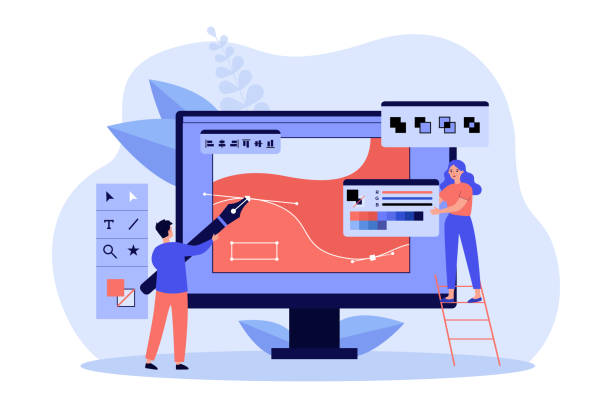
E-commerce website design is a multi-stage and complex process that requires precise planning and systematic execution.
A systematic approach can ensure that your online store not only looks beautiful but is also fully functional and optimized for commercial success.
These stages include strategy definition, design, development, testing, and final launch.
The first step is planning and research.
In this stage, business objectives, target audience, products and services, and your competitors are examined.
Determine what kind of store you need, what features are essential for it, and what your budget is.
This stage also includes selecting an appropriate domain and hosting.
A successful e-commerce site begins with a comprehensive plan.
The second stage is UI/UX design (User Interface and User Experience).
In this section, site maps, wireframes, and prototypes are designed.
The goal is to ensure that users can easily navigate the site, find products, and complete the purchasing process simply.
The visual appearance and aesthetics of the site also take shape in this stage.
An attractive and user-friendly e-commerce website design directly impacts conversion rates.
After design approval, the development and implementation phase begins.
In this stage, coding, payment gateway integration, inventory management system, search and filtering functionalities, and other technical features are implemented.
Ensuring site security through an SSL certificate and other security measures is also crucial.
This section is the heart of your online shopping website development.
After development, comprehensive testing and debugging are carried out.
All functionalities, links, forms, and purchasing processes must be thoroughly tested to ensure their correct operation.
Testing across various browsers and mobile devices is also essential.
Finally, after ensuring flawless performance, the site is ready for launch.
Even after launch, continuous monitoring, updates, and optimizations are vital for maintaining the performance and security of your online sales platform.
This step-by-step approach provides a solid foundation for long-term success.
| Stage | Key Descriptions | Importance |
|---|---|---|
| Research and Planning | Defining goals, understanding audience, platform selection, budgeting | Very High (Foundation) |
| UI/UX Design | Site map, wireframes, visual design, user experience | High (User Engagement) |
| Development and Coding | Feature implementation, payment gateway, security (SSL) | Very High (Functionality) |
| Testing and Debugging | Performance check, browser/mobile compatibility, error fixing | Medium (Stability) |
| Launch and Maintenance | Site deployment, monitoring, continuous updates | Continuous (Stability and Growth) |
The Importance of User Experience (UX) and User Interface (UI) in Increasing Sales
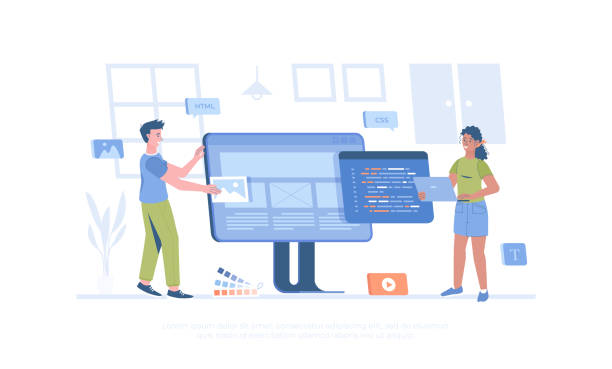
In the competitive world of e-commerce, merely having an online store is not enough; this website must be designed to attract users and provide them with an enjoyable shopping experience.
This is where the concepts of User Experience (UX) and User Interface (UI) become important.
UX (User Experience) refers to the user’s feelings and perceptions when interacting with your site, while UI (User Interface) relates to the visual and interactive aspects of the site.
A e-commerce website design with strong UX means easy navigation, a transparent purchasing process, high loading speed, and compatibility with various devices (responsiveness).
If customers cannot easily find their desired product, or if the payment process is complex and lengthy, they are likely to leave the site and go to a competitor.
Studies have shown that every second of delay in page loading can lead to a significant reduction in conversion rates.
On the other hand, an attractive and visually pleasing UI plays an important role in initial attraction and retaining user attention.
Using appropriate colors, readable fonts, high-quality product images, and harmonious visual design lends credibility to your site and builds a sense of trust in customers.
A beautiful and professional e-commerce website not only displays products better but also strengthens your brand.
The successful combination of UX and UI in building an online store can lead to a significant increase in conversion rates, a reduction in shopping cart abandonment rates, an increase in average order value, and ultimately, sales growth.
This means investing in visual design, logical information layout, and clear paths for user action (مانند دکمههای “افزودن به سبد خرید” or “ادامه پرداخت”).
The successful combination of UX and UI in building an online store can lead to a significant increase in conversion rates, a reduction in shopping cart abandonment rates, an increase in average order value, and ultimately, sales growth.
This means investing in visual design, logical information layout, and clear paths for user action (such as “Add to Cart” or “Proceed to Checkout” buttons).
The design should be user-centric, anticipate their needs and expectations, and provide a flawless experience.
This is an investment in the future of your business, and its importance to the success of an online store should by no means be underestimated.
Are you worried about losing customers because you don’t have a professional e-commerce website?
With e-commerce website design by RasawWeb, forget these worries!
✅ Significant increase in sales and visitor-to-customer conversion rate
✅ Professional and user-friendly design that builds customer trust
⚡ Get a free consultation from RasawWeb now!
Essential Features of a Professional E-commerce Website
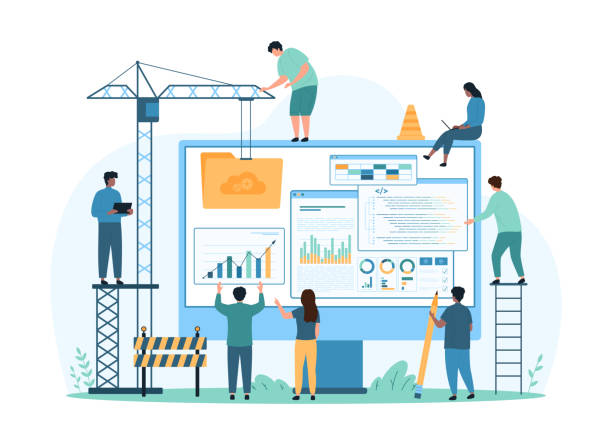
For your e-commerce website design to be successful and effectively achieve your business goals, it must be equipped with a set of essential features and functionalities.
These features go beyond merely displaying products and help improve user experience, increase customer trust, and facilitate business processes.
The first and most important section is robust product management.
This includes the ability to add complete product details (high-quality images, comprehensive descriptions, pricing, inventory, various options like color and size), product categorization for easy navigation, and the ability to quickly update information.
An advanced search and filtering system also helps users quickly find their desired product.
Second, a secure and easy shopping cart and checkout process.
Customers should be able to easily add or remove products from their cart, change quantities, and view an order summary before payment.
Integration with secure and diverse payment gateways (such as credit cards, electronic wallets, and cash on delivery) is crucial.
Ensuring an SSL certificate for encrypting sensitive customer information is of high importance and builds their trust.
Third, an order management system.
This system allows you to track orders from placement to shipping and delivery.
The ability to notify customers about order status (confirmation emails, shipping tracking) is also an important point.
Furthermore, a user account section that allows customers to view their order history, save different addresses, and edit their profiles improves the user experience.
Other features such as a discount and coupon module, a product review and rating section (which helps customers make decisions), and social media integration for sharing products can help increase engagement and sales.
Finally, strong technical support and the ability to add new features in the future will ensure the scalability and long-term success of your online sales platform.
Every professional e-commerce website design must consider these pillars.
Content Marketing and SEO Strategies for Online Stores
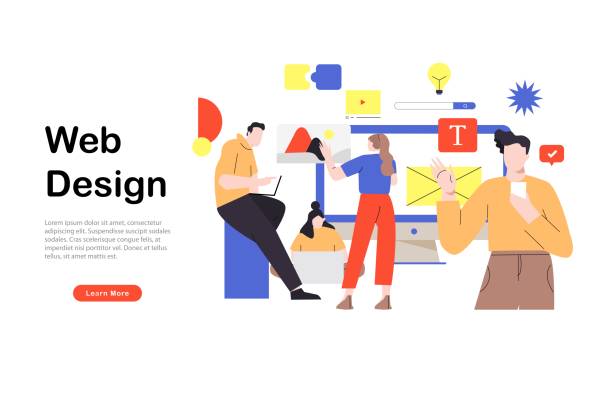
After completing your e-commerce website design, the most important next step is to ensure that potential customers can find your store.
This is where content marketing and Search Engine Optimization (SEO) strategies come into play.
Without strong SEO and engaging content, even the best e-commerce site may be overlooked amidst a flood of competitors.
SEO for online stores means optimizing your website to rank higher in Google and other search engine results.
This includes choosing appropriate keywords for products and categories, optimizing page titles (Title Tags) and meta descriptions, having an SEO-friendly URL structure, and ensuring high page loading speed.
Each product page should have unique and comprehensive descriptions that naturally incorporate target keywords.
Content marketing is also a vital component.
Creating valuable and relevant content, such as blog articles, buying guides, instructional videos, and infographics, not only helps improve SEO but also attracts audiences and guides them towards purchase.
For example, an online clothing sales website could publish articles on “Guide to Choosing the Right Size” or “Seasonal Fashion Trends.”
This content can help users in their decision-making process and position your store as a credible resource in your industry.
Furthermore, building high-quality links (backlinks) from other reputable sites to your online store increases its authority in the eyes of search engines.
Using high-quality and web-optimized images, utilizing Rich Snippets to display more information in search results, and being active on social media for product sharing are other important tactics.
Ultimately, a comprehensive SEO and content strategy significantly increases the visibility potential of your e-commerce website and drives targeted traffic to it, which is the foundation for more sales.
Common Challenges and Solutions in E-commerce Website Design and Management
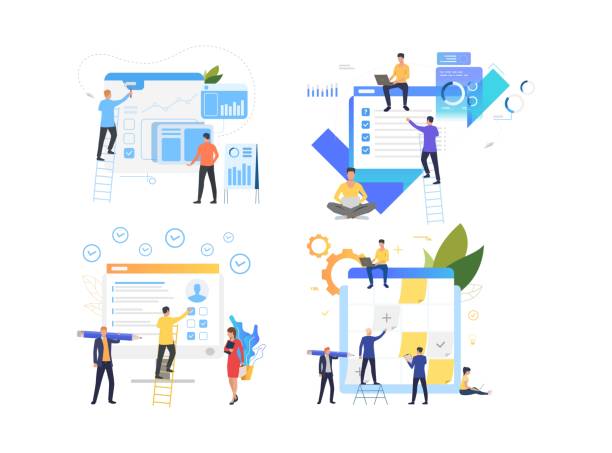
Although e-commerce website design can offer unique opportunities for businesses, this process is not without its challenges.
Understanding these challenges and having appropriate solutions to overcome them is key to success in managing an online store.
From technical issues to market competition and customer expectations, every aspect can present its own complexities.
One of the biggest challenges is cybersecurity.
Customer information, including personal and financial data, must be carefully protected.
Cyber attacks can severely damage your brand’s reputation.
Solutions include using SSL certificates, regular updates of the platform and plugins, using Web Application Firewalls (WAFs), and performing periodic security scans.
Building a secure online store is the first priority.
Another challenge is website loading speed.
Today’s users are impatient, and a slow site can lead to page abandonment.
Optimizing images, using caching, choosing strong hosting, and optimizing code are among the solutions for increasing speed.
This directly impacts the user experience and SEO of your e-commerce website.
Intense competition in the online market is another challenge.
With the continuous entry of new businesses, standing out is difficult.
To overcome this challenge, you must implement creative marketing strategies (such as content marketing, advanced SEO, targeted advertising) and focus on providing an unparalleled customer experience.
Strong after-sales service and customer support can also create a competitive advantage.
Inventory and order management can become complex, especially for growing businesses.
Using automated inventory management systems and integration with shipping systems can facilitate this process.
Finally, continuous updates and development of your online sales platform are crucial to keep pace with new technologies and customer expectations.
This includes adding new features, improving the user interface, and resolving technical issues.
With proper planning and execution, these challenges are manageable and can be turned into opportunities for growth.
| Challenge | Description | Proposed Solution |
|---|---|---|
| Cybersecurity | Protecting customer information and preventing attacks | SSL, updates, WAF, security scans |
| Slow Loading Speed | Increased bounce rate and negative user experience | Image optimization, caching, strong hosting |
| Intense Competition | Difficulty in differentiation and customer acquisition | SEO, content marketing, excellent customer experience |
| Inventory and Order Management | Operational complexity with increased sales volume | Automated systems (ERP/OMS), integration |
| Continuous Updates and Development | Falling behind technology and customer expectations | Budgeting for maintenance, collaboration with developer |
The Future of E-commerce and Innovations in Online Store Design
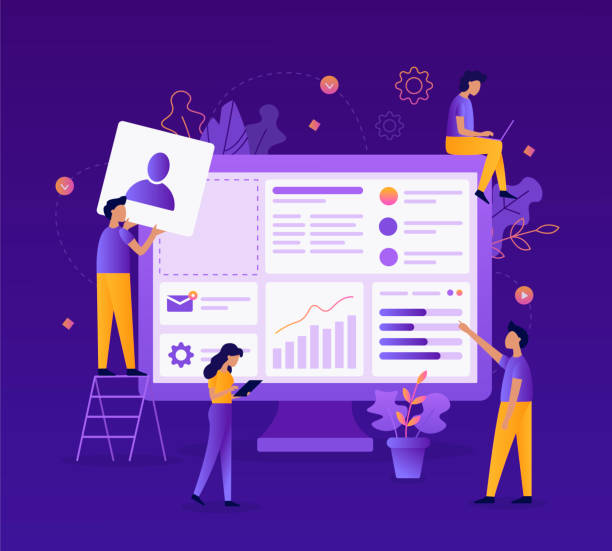
The future of e-commerce is rapidly evolving, and these developments have a direct impact on e-commerce website design and user expectations.
Technological innovations are constantly shaping how products are bought and sold online, and businesses that want to be leaders in this field must align themselves with these trends.
One of the most important future trends is the integration of Artificial Intelligence (AI) and Machine Learning (ML).
AI can significantly personalize the shopping experience.
From intelligent product recommendations based on user purchase and search history to AI-powered chatbots for customer support, AI can make interactions more efficient and satisfying.
These capabilities play a key role in e-commerce website design.
Augmented Reality (AR) and Virtual Reality (VR) are also changing how products are displayed.
Imagine customers being able to virtually place furniture in their homes or try on clothes on a virtual model.
These technologies can bridge the gap between online shopping and physical experience, increasing confidence in purchases.
Building an online store with these capabilities will be a major competitive advantage.
Voice Commerce is also growing with the increased use of voice assistants like Siri and Alexa.
Optimizing an e-commerce website for voice search means using natural language and longer keywords.
Additionally, M-Commerce (Mobile Commerce) continues to expand, and Responsive Design is critically important to ensure a flawless experience on mobile devices.
Furthermore, there is an increasing focus on sustainability and social responsibility.
Consumers are more inclined towards brands that have integrated ethical and environmental values into their business.
An e-commerce website should transparently share this information.
Ultimately, e-commerce website design in the future will move more towards personalized, interactive, and immersive experiences, and companies that embrace these trends will lead the competitive market.
Are you frustrated with your online store’s low conversion rate?
RasawWeb, with professional e-commerce website design, is your definitive solution!
✅ Increase your sales and revenue
✅ Provide an unparalleled user experience for your customers
⚡ Get a free consultation now!
How to Choose an Expert Team for Your E-commerce Website Design

Choosing the right team for e-commerce website design is a critical decision that can determine the success or failure of your project.
Given the technical complexities and strategic needs of an online store, collaborating with an expert team or company that has sufficient experience and knowledge in this field is of paramount importance.
But how can you choose the best option?
The first step is to define your needs and expectations.
Before searching, specify what type of store you need, what your budget is, and what specific features are a priority for you.
This clarity helps you filter out suitable teams.
Look for a team with specific experience in e-commerce website design using your desired platforms (such as WooCommerce, Shopify, Magento).
The second step is to review their portfolio.
A reputable web design company should provide a strong and diverse portfolio of previous e-commerce website projects.
Pay attention to the design quality, loading speed, user experience, and implemented features in these examples.
Ask them to show projects similar to your needs and explain the challenges and solutions provided.
Third, do not underestimate the importance of post-launch support and maintenance.
An online store requires continuous maintenance, updates, and troubleshooting of potential issues.
Ensure that the selected company offers comprehensive and reliable support services.
Carefully review the support contract and its terms.
Fourth, check customer feedback and company reputation.
Previous customer reviews, case studies, and testimonials can provide valuable insights into the quality of services and the professionalism of the team.
Transparency in cost estimation, project timeline, and work stages are also important points in choosing a reputable e-commerce website design team.
Choose a team that not only possesses the necessary technical skills but is also committed to a deep understanding of your business goals.
This correct choice will be a solid foundation for your long-term growth and success in the online space.
Investing in E-commerce Website Design: Added Value and Return on Investment

One of the common questions regarding e-commerce website design is whether it is an expense or an investment? The answer is clear: it is a smart investment that, if executed correctly, can yield a significant Return on Investment (ROI).
Understanding the added value and potential ROI from a successful online store is crucial for business decision-making.
The first added value is access to a wider market.
A physical store can only serve local customers, but an e-commerce website can attract customers from across the country and even the world.
This increase in reach means greater sales potential and exponential business growth.
With e-commerce website design, geographical limitations are eliminated.
Second, reduced operational costs.
Compared to a physical store that requires rent, utilities, and more staff, an online store can be operated with significantly lower costs.
There is no need for large display space, and many processes (such as order processing and customer support) can be automated or performed remotely.
These cost savings directly lead to greater profitability.
Third, the ability to collect data and analyze customer behavior.
An online store provides valuable data about visitors, best-selling products, purchasing paths, and site weaknesses.
This information is vital for optimizing marketing strategies, improving user experience and making informed business decisions.
The ability to continuously improve based on data ensures ROI.
Fourth, increased brand credibility and customer trust.
In the digital age, a professional online presence lends credibility to your business.
A quality e-commerce website design not only functions as a sales channel but also as a powerful tool for marketing and branding.
This credibility attracts new customers and retains existing ones.
Overall, investing in implementing an online store is a long-term strategy for growth and prosperity in the digital world.
Frequently Asked Questions
| Question | Answer |
|---|---|
| What is e-commerce website design? | E-commerce website design refers to the process of building and developing an online platform that allows users to purchase products or services online. This includes user interface design, user experience, security, shopping cart, and payment gateway. |
| Why is having an e-commerce website important for businesses? | Having an e-commerce website allows businesses to operate 24/7, expand their target market, reduce operational costs, and provide easier access for customers to their products. |
| What are the most important features of a successful e-commerce website? | The most important features include excellent User Interface and User Experience (UI/UX), high loading speed, security (SSL and secure payment gateway), Responsive Design, Search Engine Optimization (SEO), and easy product and order management. |
| What is the role of SEO in e-commerce website design? | SEO helps your e-commerce website achieve a higher ranking in Google and other search engine results. This leads to an increase in organic visitors and, ultimately, an increase in sales. |
| What is the importance of security in e-commerce websites? | Security is vital for protecting sensitive customer information (such as banking and personal data). Using an SSL certificate, secure payment gateways, and adhering to security standards builds customer trust and prevents fraud. |
| What are the common platforms for e-commerce website design? | Common platforms include WooCommerce (for WordPress), Shopify, Magento, PrestaShop, as well as custom development, each with its own advantages and disadvantages. |
| What does Responsive Design mean in an e-commerce website? | Responsive Design means that your e-commerce website is displayed correctly and optimally on any device (mobile, tablet, laptop). This is very important for user experience and SEO. |
| How can User Experience (UX) be improved in an e-commerce website? | User experience can be improved by simplifying the purchasing process, easy navigation, attractive visual design, providing complete product information, customer reviews, and online support. |
| What is the role of product images and descriptions on an e-commerce website? | High-quality images and complete, accurate product descriptions help customers make better decisions and build trust in the product. This directly impacts the Conversion Rate. |
| What is the importance of customer support on e-commerce websites? | Strong and quick customer support leads to increased customer satisfaction and loyalty. Providing various support channels (phone, online chat, email) and responding to questions and resolving issues enhances the store’s credibility. |
And other services from RasawWeb Advertising Agency in the field of advertising
Smart Content Strategy: A professional solution for digital branding with a focus on user experience customization.
Smart Advertising Campaign: Revolutionize SEO ranking improvement with the help of user experience customization.
Smart Social Media: Designed for businesses seeking online growth through SEO-driven content strategy.
Smart Marketplace: An effective tool for customer acquisition through marketing automation.
Smart Marketing Automation: A professional solution for analyzing customer behavior with a focus on custom programming.
And over a hundred other services in the field of internet advertising, advertising consultation, and organizational solutions
Internet Advertising | Advertising Strategy | Advertorials
Resources
Advantages of E-commerce Website Design for Businesses
Key Success Factors in Online Stores
The Importance of SEO in E-commerce Website Design
Comprehensive Guide to Professional Online Store Design
? Ready to revolutionize your business in the digital world? RasawWeb Digital Marketing Agency, specializing in website design with a modern user interface and comprehensive marketing strategies, is with you to establish a powerful and influential online presence.
📍 Tehran, Mirdamad Street, next to Bank Markazi, Kazeroun Jonoubi Alley, Ramin Alley No. 6
